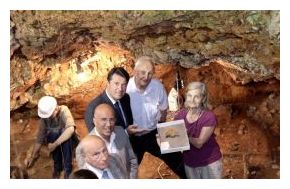
Part of a prehistoric skull, dating back 170,000 years, has been discovered during an archaeological dig in Nice. Experts say the discovery could reveal important clues to the evolution of Neanderthals.
Students Ludovic Dolez and Sébastian Lepvraud were working on the excavation site, Lazaret Caves, on 13th August, when they came across the partial remains of a forehead belonging to a Homo Erectus.
Paleontologist Marie-Antoinette de Lumley, who has been in charge of excavation at Lazaret since 1961, said the bone is an important find: "It belonged to a nomad hunter, less than 25 years old. He may be able to teach us more about the evolution of his successor, the Neanderthal man."
The bone was left to dry for a few days where it was discovered, before being removed for a special public announcement attended by Nice Mayor Christian Estrosi.
Archaeologists have been searching this site patiently for 50 years, unveiling more than 20,000 bone fragments from prehistoric animals.
The last human discovery in the cave was in 2009, when the molar tooth of a child was uncovered.



Sorry, couldn't resist.
Good work...but Erectus wasn't "predecessor" of Neandertal: they were the same people...they have their morphology analysis incorrect.
Frankly, they would look at a French man and a contemporary Italian remains, and if they weren't twins separated at birth, these "experts" would label them different "modern humans."
They were MODERN HUMANS evolving into what we look like today. 150,000 years old?
That means they'd been there for @ 2.35 million years.